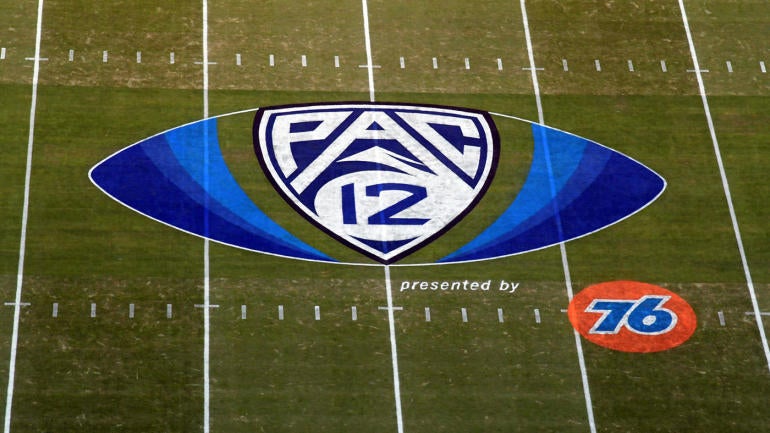
Long before the Pac-12 ever had 12 members, it dealt with uncertainty. Had Arizona and Arizona State not received invitations to the Pac-8 in December 1976, the conference might have broken up, according to then-Cal athletic director Dave Maggard.
"The threat of USC pulling out was very real and UCLA might have followed suit," Maggard told The Associated Press at the time.
The addition of the Wildcats and Sun Devils turned the league into the Pac-10, which is how it remained for more than three decades until the first seismic wave of conference realignment began in 2010. Without their additions, the last few decades of college athletics could have looked vastly different.
The invitations to the Arizona schools came above objections from schools in the league's northern footprint worried about a geographical shift in the balance of power. Amid all the politics, however, the league survived and continued on well into the 21st century as one of the most powerful in college athletics. The Pac-12's zenith came in the 2012-13 fiscal year, when it led all Power Five conferences in revenue on the heels of a new media rights deal that was widely praised.
The triumphant times were short-lived. In 2022, USC and UCLA finally pulled the plug -- as had been feared back in the 1970s -- and announced they would leave for the Big Ten in 2024. That opened the floodgates to drown a league that is now on life support with Oregon and Washington heading to the Big Ten in 2024. Also departing the Pac-12 for the Big 12 are Arizona, Arizona State, Colorado and Utah.
That leaves Cal, Oregon State, Stanford and Washington State as the lone remaining Pac-12 schools. Each have been in the league for more than a century and are now looking around at the ashes surrounding their athletic home and thinking, "What in the world happened here?"
Here is an attempt to answer that question with a chronological review of the Pac-12's demise:
New boss and early expansion (2009-2011)
Larry Scott hired as Pac-10 commissioner
July 1, 2009: Scott succeeded Tom Hansen, who served as the Pac-10 commissioner for 26 years. As CEO of the Women's Tennis Association, Scott was lauded for his marketing and TV acumen at a time when the Pac-12 needed to land a lucrative TV rights deal to remain competitive in the power conference landscape.
"Our search committee was most impressed with Larry's broad range of leadership experiences in both men's and women's sports," said Bob Bowlsby, who was then the Stanford athletic director and later Big 12 commissioner.
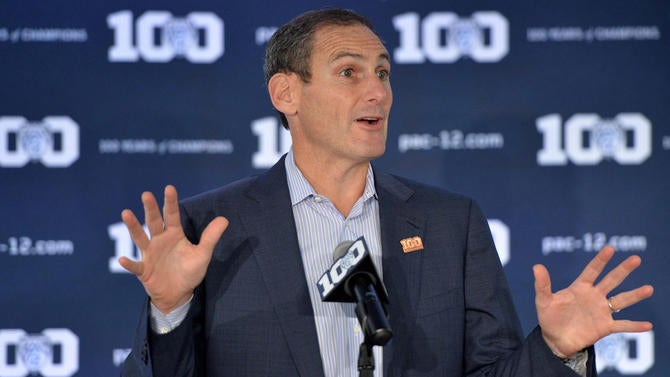
Big Ten starts looking at expanding
Dec. 15, 2009: The Big Ten officially started exploring possible expansion as league commissioner Jim Delany announced a 12-to-18 month timeline to provide recommendations for possible new members. The Big Ten's growth foray came as it enjoyed successful early returns on the Big Ten Network, the first of its kind in college sports.
Pac-10 jumps into expansion game
Feb. 9, 2010: It was a teleconference designed to introduce Kevin Weiberg, the Pac-10's new deputy commissioner, but the headlines emerging from it centered on expansion. Scott acknowledged being in the "very preliminary" stages of exploring conference additions, adding "it really is over the next six to 12 months that we'll start having serious analysis and serious conversations."
Embracing expansion aligned with the Pac-10's sights of a new media rights deal to replace the one expiring at the end of the 2011-12 academic year. That made Weiberg's hire "very significant" (as described by Scott) given his experience launching the Big Ten Network.
USC receives NCAA penalties
June 10, 2010: USC received a two-year postseason ban from the NCAA amid its coaching transition from Pete Carroll to Lane Kiffin. Saddled by the sanctions, the Pac-10's premier program struggled to maintain its footing among the nation's elite. Since winning the 2004 BCS National Championship, the Trojans have not played for a national title or reached the College Football Playoff. A diminished USC was good for Pac-10 parity, but the league suffered without its best brand in top form.
First realignment moves
June 11-12, 2010: The first realignment domino fell when the Pac-10 announced Colorado as a new member. The Buffaloes were followed out of the Big 12 the next day by Big Ten-bound Nebraska. With two members gone and the Pac-10 eyeing several more, the Big 12's future seemed uncertain. All eyes turned to Texas as Scott traveled south to pitch a 16-team super conference that would include the ambitious additions of Texas and Oklahoma.
Big 12 survives, Texas gets TV network
June 14-17, 2010: Despite rampant speculation that Texas, Oklahoma, Oklahoma State, Texas Tech and possibly Texas A&M would join Colorado in the Pac-10, the Big 12 stayed afloat. The Big 12's willingness to accommodate Texas' own TV network played a significant role in the Longhorns' decision to stay; they would have had to share any revenue equally in the new-look Pac-10, according to the Los Angeles Times. Scott abandoned the push for a 16-team league and instead poached Utah from the Mountain West. When the Utes and Colorado join the conference in July 2011, it gives the Pac-10 its 12th member and the league rebrands itself the Pac-12.
Equal revenue push
October 2010: Pac-10 schools featured in network broadcasts split 64% of the revenue from the game under the league's existing revenue model. As the Seattle Times explained, this system benefitted UCLA and USC, who were often featured on TV. But Scott wanted schools to share revenue equally under the next media rights deal. It was the same approach he employed in talks with Texas, which wanted to keep profits from the Longhorn Network. Scott's unwillingness to sweeten the pot for premier brands such as UCLA, USC and Texas can be identified as a perilous blunder in retrospect.
Auburn edges Oregon for national title
Jan. 10, 2011: Following USC's 2004 national title, the Pac-10 came just short of producing its second BCS champion when Oregon fell 22-19 to Auburn for the national championship.
Pac-10 strikes new TV deal (2011)
Hitting the TV jackpot
May 3, 2011: The Pac-10 surged to the top of the TV revenue charts in college sports when it inked a 12-year deal with Fox and ESPN worth close to $3 billion. The deal equated to an expected annual payout of between $225 million and $250 million for the league, essentially quadrupling its revenue from the prior deal. It usurped the annual payouts of the Big Ten ($220 million), SEC ($205 million), ACC ($155 million) and Big 12 ($130 million); however, each of the other four Power Five leagues negotiated at least one new media rights deal during the 12-year duration of the Pac-10's agreement. University leaders were elated at the time, but the length of the contract turned out to be its downfall.
"The new agreements dramatically increase our national exposure while providing a solid, long-term financial foundation to help ensure we remain self-sufficient," Oregon athletic director Rob Mullens said at the time.
Realignment kicks up again
Sept. 2-3, 2011: With Texas A&M reportedly on the cusp of receiving an SEC invitation, the Big 12's future again looked murky, and the newly-renamed Pac-12 stood to gain from its potential demise.
"I will say schools have reached out to us," Scott said. "We are not doing anything proactively."
Pac-12 and Texas won't compromise
Sept. 20, 2011: With Texas reportedly unwilling to commit to equal revenue sharing, Scott did not take an expansion vote to Pac-12 presidents. Texas, Oklahoma, Oklahoma State and Texas Tech would have brought the league's membership to 16 and inflicted a brutal blow to the Big 12, which was already losing Missouri and Texas A&M to the SEC. Instead, the Pac-12 forged ahead with its equal revenue sharing and the Big 12 survived another day.
"We could have expanded, but the deal didn't make any sense at the end of the day for us, especially given the position that we are in," Scott told reporters. "There is a very high bar. It's hard to imagine very many scenarios for our conference to expand because the bar is so high."
Though Scott acknowledged that expansion could have generated more money for Pac-12 schools, he also said that it "could have torn apart the fabric of the culture of the conference."
If the Pac-12 had accommodated Texas by allowing an unequal revenue sharing model, it would have drastically altered the college sports landscape and left the Big 12 in shreds financially. It also would have bolstered the Pac-12's football strength early in what turned out to be a debilitating stretch of waning national success.
Pac-12 snags cushy headquarters
Dec. 16, 2011: Flush with a rosy financial outlook on the heels of a newly signed media rights deal, the Pac-12 signed a lease for 70,000 square feet of office space in the SOMA district of San Francisco known for its tech-centric feel. The venue also served as the headquarters of the Pac-12 Networks. It would later come under scrutiny as an unnecessarily lavish expense as the league began to struggle.
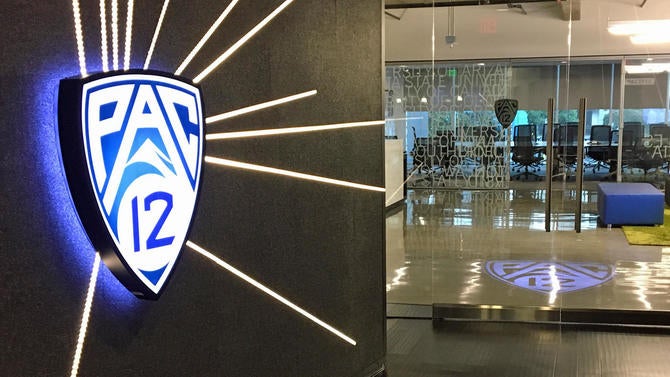
TV arms race heats up (2012-2013)
Pac-12 Networks debut
Aug. 15, 2012: The Pac-12 launched seven channels with ambitions of returning $30 million per year to its members. It was an underwhelming rollout, however, with more Big Ten Network subscribers in San Diego than Pac-12 Networks subscribers on launch day. That was partially because the Pac-12 Networks had not landed a distribution agreement with DirecTV, among others.
Unlike the SEC Network, which was a joint venture with ESPN, and the Big Ten Network, which was a joint venture with Fox, the Pac-12 Network would be solely owned by the conference. While that positioned the league to capitalize on its success, it also required significant investment and financial risk that eventually backfired.
Big 12 catches up with new deal
Sept. 7, 2012: Having survived the losses of four programs to three different conferences, the Big 12 finally got rewarded. With Texas and Oklahoma staying after two rounds of serious flirting with the Pac-12, the league signed a new media rights deal roughly on par with the Pac-12's per-school revenue distribution. Texas, as part of the agreement, kept its profits from the Longhorn Network.
Pac-12 blamed for failed scheduling alliance
Nov. 19, 2012: Big Ten commissioner Jim Delany suggested his league's expansion to 14 (adding Maryland and Rutgers) wouldn't have been necessary if the Big Ten and Pac-12 could have finalized a proposed scheduling agreement. The idea received pushback from Pac-12 coaches, however, because of the conference's nine-game league slate.
While blame is often assigned to the Pac-12's chancellors, presidents and commissioners for the league's demise, this failed scheduling proposal and others like it in the future demonstrated that coaches were also complicit in failing to embrace changes that could have generated more revenue.
Pac-12 tops revenue chart
June 12, 2013: According to figures obtained by USA Today, the Pac-12 finished the 2012-13 fiscal year as the richest in college sports. The league reported $334 million in total revenue -- by comparison, the Big Ten reported $318.4 million and the SEC reported $314.5 million -- as it enjoyed the financial spoils of its new TV deal at a time when other power conferences had yet to capitalize on the skyrocketing TV value of live college sports. How much of that revenue schools actually got to keep would soon become a point of contention as the conference dealt with unruly overhead expenses.
CFP era begins; ACC, Big Ten ink TV deals (2014-2017)
Pac-12 underdelivers to members
June 2014: At a time when the other Power Five conferences each returned at least 90% of league revenues back to members, CBS Sports reported the Pac-12 returned just 68% of its revenue to members for the 2013 fiscal year. League officials blamed the discrepancy on costs incurred from running Pac-12 Networks from new studios and offices in San Francisco.
Ohio State beats Oregon for CFP title
Jan. 12, 2015: Ohio State beat Oregon 42-20 in the first College Football Playoff National Championship. Six Pac-12 teams finished in the final AP Top 25 and the league was 5-2 in non-CFP bowls. A Pac-12 team has not played in the CFP National Championship Game since.
Pac-12 turns 100
Summer 2015: As the Pac-12 celebrated its 100th anniversary, the loss of its brief hold atop the conference revenue chart came into focus. Just two years after its $334 million revenue for the 2012-13 year beat even the Big Ten and SEC, the Pac-12 was surpassed by both. The SEC generated a record $455 million in revenue in 2014-15, just one year after the Big Ten surpassed the Pac-12 with $338.9 million in revenue for 2013-14. One of the reasons why? The SEC and Big Ten networks were thriving in partnership with ESPN and Fox, respectively. Meanwhile, the Pac-12 Networks continued struggling with distribution.
Big 12, Pac-12 discuss scheduling alliance
Summer 2016: The Big 12 spoke with the Pac-12 about a scheduling alliance to bolster each league's nonconference schedules in the CFP era. Another idea along similar lines surfaced in 2018 (reported on by CBS Sports in 2019) highlighting how an inventory of 30 annual contests between Big 12 and Pac-12 schools could've helped close the widening revenue gap between those two leagues and the other Power Five conferences. Ultimately, nothing stuck.
ACC agrees to 20-year extension
July 21, 2016: The ACC and ESPN announced an extension of their media rights agreement through the 2035-36 season and the launch of an ACC Network. Though this temporarily made the ACC financially competitive with other Power Five conferences, the deal's length became problematic as the Big Ten and SEC signed mega-deals in the coming years.
Washington marks Pac-12's last CFP appearance
Dec. 31, 2016: After getting shut out of the CFP in the 2015 season, the Pac-12 returned as No. 4 seed Washington lost 24-7 to No. 1 seed Alabama in a CFP Semifinal matchup in the Peach Bowl. A Pac-12 team has not been to the CFP since.
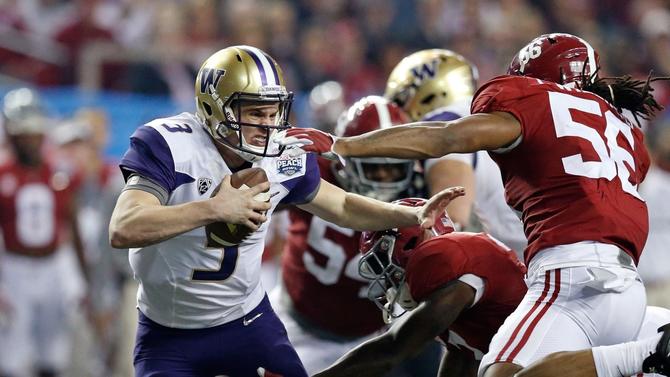
Big Ten announces new deal
July 24, 2017: The Big Ten announced a six-year, $2.64 billion TV deal with Fox and ESPN that also included CBS for basketball games. The deal roughly tripled the conference's previous media rights agreement and far outpaced the Pac-12's deal Scott had been so widely praised for six years earlier.
Cracks form; COVID shortens season (2018-2020)
Internal concerns mount
Spring 2018: On the heels of a lackluster 2017 season in which the Pac-12 finished 1-8 in bowl games, and with other conferences pulling ahead from a financial perspective, some members became vocal about their concerns with the league's direction.
"This is a concern of the Pac-12 presidents, and I can tell you it's a large discussion point with meetings with the commissioner at every single meeting," Washington State president Kirk Schulz said. "The Pac-12 schools have got to be competitive with the ACC, the SEC and the Big Ten and Big 12, and we're falling behind."
Embarrassing salary comparisons
Nov. 27, 2018: In the first a of a four-part series shining a light on the Pac-12's problems, the Oregonian examined some eye-opening salary discrepancies among Power Five commissioners. Reporter John Canzano noted how Scott's $4.8 million salary dwarfed SEC commissioner Greg Sankey's $1.9 million salary and the $2.4 million salary of Big Ten commissioner Jim Delany. While every SEC football coach made more than Sankey at the time, none of the Pac-12's head coaches made more than Scott -- even as the league fell behind in revenue distribution and overall prestige.
At the same time, the Pac-12 was dealing with an officiating controversy and had hired a PR firm to help repair its image. Things were officially souring in the Conference of Champions.
Pac-12 floats private investment
Winter 2019: With the league floundering, Scott pursued a private equity lifeline. The plan called for the Pac-12 to bundle its assets into an entity called "Pac-12 NewCo" with the goal of soliciting $500 million in exchange for a 10% stake in the league. Later in 2019, Scott told the Mercury-News that the league's presidents and chancellors ruled out the proposal.
USC AD turns heads
Feb 27, 2020: USC athletic director Mike Bohn raised eyebrows with comments to USC's 247Sports site that "everything is on the table" for the Trojans in terms of their future conference affiliation.
"There's no talk of [leaving], but guess what? If it was on the table, we would certainly explore that," Bohn said. "But I've got to be careful. The league is really tender."
Pac-12 waffles on 2020 season
Aug. 11, 2020: Amid the COVID-19 pandemic, the Pac-12 followed the Big Ten's lead and announced it would not play in 2020, but instead hold a season in the spring of 2021. Just six weeks later, the Pac-12 reversed course, announcing it would play a seven-game season beginning on November 6 without fans. The snafu only perpetuated the narrative that the Pac-12 wasn't serious about college football. No league members finished inside the top 20 of the AP poll.
SEC lands new TV deal
Dec. 10, 2020: The SEC and ESPN announced a 10-year, $3 billion media rights agreement to begin in 2024-25 that made ESPN and the SEC Network the conference's exclusive partners. Further separation is created between the SEC and Big Ten and the rest of the power conferences.
Change in leadership; membership defections (2021-present)
Scott's tenure as commissioner ends
Jan. 20, 2021: With his contract set to expire June 30, Scott and the Pac-12 "mutually agreed" to part at its conclusion. Asked what his legacy would be, Scott told CBS Sports' Dennis Dodd, "I don't know. That's for others to say."
Scott claimed the league was "very well-positioned" for its next TV contract. But because of the Pac-12 Network's failure under his leadership, it became clear that the league wouldn't be able to keep up financially with the Big Ten and SEC. Had Scott been willing to partner with an existing network for help with producing and distributing Pac-12 Networks content, perhaps the league could have found the financial footing required to keep UCLA and USC satisfied. Instead, he insisted on an equal revenue sharing model that hampered expansion attempts and contributed to the unhappiness of the Los Angeles schools.
While Scott's ideas on expansion and a league TV network were sound, he failed to execute. The 12-year length of the media rights deal spearheaded by Scott also became an anchor as the conference slipped from first to last among the Power Five schools in media rights distribution over its duration.
George Kliavkoff replaces Scott
May 13, 2021: The Pac-12 turned to another non-traditional choice in choosing Kliavkoff as Scott's replacement. Kliavkoff arrived from MGM Resorts International, where he was president of entertainment and sports. He was immediately thrown into a changing college sports landscape. COVID-19 concerns were still lingering, Allowing athletes to earn money from their name, image and likeness in addition to more lenient transfer rules were changing the college athletics and realignment was about to rock the NCAA again. Kliavkoff also needed to negotiate a new TV deal as the once-praised but increasingly insufficient 12-year media rights deal neared its completion.
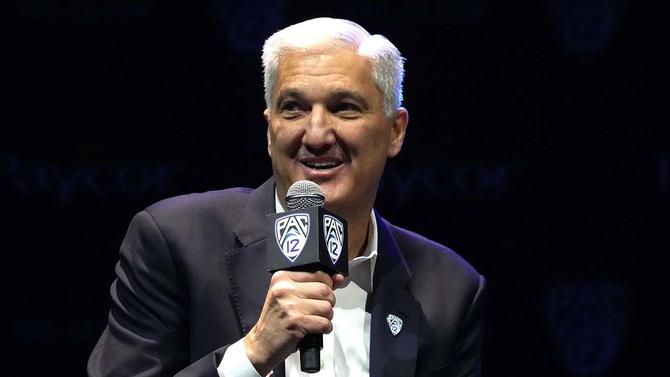
Oklahoma and Texas join SEC
July 21, 2021: The college sports world was turned on its head by a report from the Houston Chronicle that Oklahoma and Texas were interested in joining the SEC. Within days, the Sooners and Longhorns had accepted invitations from the league. Thus, the Big 12's future became uncertain.
Speaking a couple of weeks after the chaos, Kliavkoff was cool on expansion, saying the league would not be "reactively poaching any schools." But with this laissez-faire approach during a historic moment in college sports, Kliavkoff and the Pac-12 missed an opportunity to solidify their ranks with leftover Big 12 schools.
Pac-12, ACC, Big Ten form alliance
Aug. 24, 2021: The announcement that the ACC, Big Ten and Pac-12 were forming an alliance with the unspoken intent of combatting the SEC's expansion was light on specifics but heavy on theatrics. There was no contract to formalize the partnership or details on what it would entail, but ACC commissioner Jim Phillips said "we looked each other in the eye." Noticeably absent from the alliance was the Big 12 as it was reeling from the departure of its two biggest brands.
Big 12 finds reinforcements
Sept. 10, 2021: With the Pac-12 standing down on expansion, it allowed Big 12 commissioner Bob Bowlsby a chance to restock and save his league. He did so by adding BYU, Cincinnati, Houston and UCF.
UCLA and USC bolt for Big Ten
June 30, 2022: UCLA and USC plunged a knife into the heart of the Pac-12 and threw "The Alliance" out the window when they accepted Big Ten invitations and created a geographically misaligned super conference. The two Los Angeles universities made it clear they believed a better future awaited in the Big Ten.
After passing up a chance to become hunters, the Pac-12 had officially become the hunted. Still, this reality did not appear to fully resonate with league leadership, which seemed more concerned with the academic research affiliations of potential expansion candidates than with the crushing reality that their league was unstable after losing two of its most valuable members.
Big 12 makes initial advance
July 5, 2022: CBS Sports learned that the Big 12 was in discussions to add up to six of the remaining Pac-12 schools just days after it lost the Trojans and Bruins. Amid the chaos, the Pac-12 announced it would immediately begin negotiations on its next TV contract, intending to go forward with at least its 10 remaining members.
Big Ten signs huge TV deal
Aug. 18, 2022: The Big Ten announced a seven-year, $8 billion media rights deal with CBS, Fox and NBC. It marked the largest-ever media rights agreement for a conference and further saturated potential Pac-12 partners with live broadcasts.
Big 12 hops the line
Oct. 30, 2022: The Big 12 had one more year remaining on its deal than the Pac-12, but that didn't stop the conference from signing a new media rights agreement first. Led by the increasingly aggressive Yormark, the Big 12 finalized a six-year, $2.3 billion extension in its media rights deal with ESPN and Fox, securing its future even after the departures of Texas and Oklahoma.
The Big 12's move left little linear air time available for the Pac-12. With the ACC, Big Ten and SEC also on long-term TV deals, the Pac-12 was the last arrival to the media rights buffet, and there wasn't much left to pick from.
Good season with a cloud
Jan. 1, 2023: Though it was the Pac-12's sixth straight season without a team in the CFP, it was still a good season by the conference's sinking standards. Led by an infusion of new coaches and high-caliber quarterbacks, the league had four teams finish in the top 15 of the AP poll and six in the top 25. But the success came with a cloud lingering overhead as the conference grappled with the looming departures of UCLA and USC for the Big Ten while also dealing with an uncertain financial future amid ongoing media rights negotiations.
Pac-12's negotiations stumble
Winter 2023: Months after the Big 12 signed a new media rights deal paying schools close to $32 million annually, the Pac-12 continued spinning its wheels in the mud as the last power conference without a long-term agreement. CBS Sports reported on March 3 that the Big 12 was showing renewed interest in the Pac-12's "Four Corner" schools -- Arizona, Arizona State, Colorado and Utah -- as expansion candidates.
Trying to calm the masses
July 21, 2023: Making his first public remarks in nearly a year, Kliavkoff said at Pac-12 Media Day that the conference's schools were "committed to each other and to the Pac-12." Though ESPN had dropped out of the conference's increasingly floundering negotiations for a new media rights deal, Kliavkoff tried to strike an optimistic tone about those negotiations.
"I will tell you what we've seen is that the longer we wait for our media deal, the better our options get," Kliavkoff said. "I think our board realizes that."
Kliavkoff claimed there were "bigger fish to fry" beyond realignment. He predicted the Pac-12 would sign a new media rights deal and that the realignment cycle would end. It was yet another miscalculation and one that would have dire consequences.
Colorado bounces for the Big 12
July 27, 2023: Without even seeing Kliavkoff's presentation on potential media rights deals, Colorado's board of regents voted unanimously to join the Big 12. It was a blow that left the Pac-12 with just nine members and without the attraction of Colorado's blockbuster first-year coach Deion Sanders as a leverage piece in TV negotiations.
Kliavkoff presents Apple deal to members
Aug. 2, 2023: Faced with a brewing crisis, Kliavkoff presented a streaming-centric media rights proposal from Apple to league members for consideration. University leaders were lukewarm on the deal's lack of linear exposure and subscription-based payout incentives. With a reported base payout of roughly $20 million annually per school, the deal would have left the Pac-12 significantly behind its Power Five peers. With the Big Ten and Big 12 lurking, the league's fate hung in the balance.
Five more leave as the Pac-12 crumbles
Aug. 4, 2023: Restless amid the underwhelming proposal, Pac-12 schools headed for the exits. Oregon and Washington left for the Big Ten, while Arizona, Arizona State and Utah followed Colorado to the Big 12. In their wake, they left the smoldering embers of a league with more than a century of tradition. They also left four members -- Cal, Oregon State, Stanford and Washington State -- trapped in the wreckage and looking for a way to salvage the future of their athletic departments.
Final word: What went wrong
If Pac-12 leaders had been willing to bend a knee to Texas during realignment over a decade ago, the Longhorns likely would have brought Oklahoma and other Big 12 reinforcements with them to form a mega-conference anchored in football by USC, Oregon, Oklahoma, Texas, Stanford and potentially Utah. It would arguably have made the Pac-12 the nation's strongest league both on the field and in financial value.
Despite settling for Plan B in expansion, Scott signed what seemed like an excellent media rights deal. However, the 12-year length of the agreement turned out to be an albatross as other leagues negotiated new, richer deals. The league's insistence on an equal revenue sharing plan also ended a sweetheart deal for UCLA and USC, dropping the Los Angeles powers to equal footing with league peers in annual payout.
Then, as the Big Ten Network and SEC Network took off and lined those conferences' coffers with cash, the Pac-12 Networks floundered. Scott's salary and the overhead expenses of running and owning the network chipped away at the league's financial standing and Scott's reputation. Lackluster on-field performance also zapped the Pac-12's momentum during the 2010s.
Fed up, UCLA and USC departed as new commissioner George Kliavkoff struggled to land a competitive media rights deal without the Bruins and Trojans as part of the package. Still, there were opportunities to expand or partner with other leagues that the Pac-12 opted not to pursue. Ultimately, it was hopped in line by a resurgent Big 12 in media rights negotiations, which left the conference with little path forward. In the end, it all combined to create the demise of a once-proud league that was vital to the fabric of college sports for decades.
















